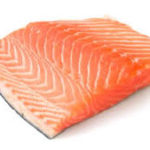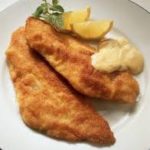
The 13 best fish as listed recently in Us News & World Report,*follow:
- Wild Salmon – versus farmed salmon which may experience overcrowding, exposing fish to chemicals, bacteria and disease.
- Artic Char – or iwana on a sushi bar, It is farmed but in a chemical free environment.
- Mackerel – Atlantic mackerel is fine. Spanish and King mackerel have potential for mercury contamination.
- Sardines – fishing has been closed due to decline in sardine population.
- Sablefish/black cod – Go with Sablefish caught off California, Alaska or British Columbia where there is less likelihood of getting another species. It does have moderate mercury content and children under 12 should limit to 2 times a month.
- Anchovies – has low mercury levels and high omega-3’s.
- Oysters or kaki on the sushi bar.
- Rainbow trout – indoor farming with a series of filters to keep the fish clean control chemical pollution and render these fish safe.
- Albacore tuna – Use those caught in the North Atlantic Ocean or Pacific Ocean where fishing methods are used that do not snag other species. Children under 5 should limit to 2 times a month.
- Mussels – or murugai on the sushi bar. Farmed are OK as they are done in an environmentally responsible manner.
- Pacific Halibut is available and fine. Atlantic Halibut is almost depleted. Children 5 and under only 2 times a month.
- Rockfish – all species are good.
- Catfish – Use only U.S. Catfish. They are low in mercury. Avoid Catfish from Vietnam, Thailand and China.
Another report suggests to buy wild varieties (versus farmed) whenever possible. Fish from the large commercial fisheries are fine. Look for the blue and white symbol from the Marine Stewardship Council on wild Alaskan salmon, Oregon pink shrimp and North Pacific sablefish. The symbol proves that the fishery is meeting all local, national and international laws of keeping its fish population at a sustainable level and minimizing environmental impact.**
Also they suggest to buy domestic fish as the U.S. has the most closely regulated fisheries in the world, except for the northern European fisheries which are also certified by the Marine Stewardship Council. Fish are labeled according to the origins of the fishing boat. Thus if a fish is caught off the European coast by an American boat, the fish is labeled as domestic.
Organic does not always mean “organic”. The U.S. Department of Agriculture does not have a certification program for organic seafood. A few shrimp farms do have a USDA organic certification as they qualify as livestock farms. If fish are labeled as “organic” it may mean that the fish ate organic foods in the farm where they were raised or that the fish were not treated with antibiotics or hormones.

The fish that contain the most omega-3 fatty acids are:**
- Anchovies
- Arctic char
- Atlantic mackerel
- Herring
- Rainbow trout
- Sablefish
- Sardines
- Wild salmon
- Yellowfin tuna.

This article also suggests to avoid or limit eating some fish:**
Know which fish contain the most methylmercury and avoid or limit consumption of them. Pregnant women, women who may become pregnant, nursing mothers and young children should avoid:
Atlantic swordfish shark
King Mackerel Tilefish
Marlin Tuna (bigeye or ahi)
Orange roughy
Fish to eat no more than
Fish to eat no more than three times per month because of mercury content include:
Bluefish
Chilean sea bass
Grouper
Mackerel (Spanish or Gulf)
Tuna (albacore or yellowfin)
Fish to eat no more than six times per month because of mercury content include:
Alaskan cod Bass (striped or black) Carp
Halibut Jacksmelt Lobster
Mahi mahi Monkfish Perch (freshwater)
Sablefish Skate Snapper
Tuna (canned chunk lite or skipjack)
Weakfish (sea trout) White Pacific Croaker

* Hobson, Katherne and Zunderhill, Allison, 13 Best Fish: High in Omega-3’s & Environment-friendly, US News & World Report, June 29, 2016.
** 7 Facts and Tips When Buying Fish, Nutrition Dimension, Fall 2015.


